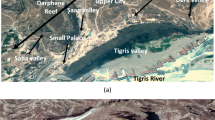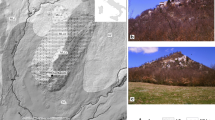Abstract
The paper reports a geostructural and geognostic survey to evaluate the stability conditions of the highly fractured calcareous cliff where the Monastery of the “Frati Minori” of Ispica is located. A large number of fractures affect the whole cliff, resulting in dangerous conditions. In addition to a careful inspection of the slope to measure the structural discontinuities and identify rock blocks larger than 1 m3, cored boreholes were extended to a depth of 30 m. The rock quality designation indicated that the rock quality varies from poor to fairly good. In this steep, vegetated area, the use of different investigation methods was necessary to determine the physical, mechanical and geometric parameters necessary to plan the remedial works and measures to reduce the risk of rocks falling.
Résumé
L’article présente une étude géo-structurale et géo-gnostique destinée à évaluer les conditions de stabilité de la falaise calcaire fortement fracturée où se situe le monastère de « Frati Minori » d’Ispica. De nombreuses fractures affectent l’ensemble de la falaise, générant des conditions de danger. En plus d’une inspection soignée des pentes destinée à la mesure des discontinuités structurales et à l’identification des blocs rocheux plus grand que 1 m3, des sondages carottés ont été réalisés sur 30 m de profondeur. L’indice RQD a montré que la qualité du massif varie de mauvaise à moyennement bonne. Sur cette surface escarpée et couverte de végétation, l’utilisation de différentes méthodes d’investigation était nécessaire afin de déterminer les paramètres physiques, mécaniques et géométriques nécessaires pour définir les travaux de confortement et les mesures permettant de réduire le risque de chute de blocs.








Similar content being viewed by others
References
Barton NR (1973) Review of a new shear strength criterion for rock joints. Eng Geol 7:287–332
Barton NR, Choubey V (1977) The shear strength of rock joints in theory and practice. Rock Mech 10(1–2):1–54
Bieniawski ZT (1973) Engineering classification of jointed rock masses. Trans S Afr Inst Civ Eng 15:335–344
Bieniawski ZT (1989) Engineering rock mass classifications. Wiley, New York, 251 pp
Carbone S, Di Geronimo I, Grasso M, Iozzia S, Lentini F (1982) I terrazzi marini quaternari dell’area iblea. Contr. alla realizzazione della Carta Neotettonica d’Italia C.N.R., P.F. Geodinamica, No 506, (Giannini Ed.) Napoli
Deere DU (1963) Technical description of rock cores for engineering purposes. Felsmechanik und Ingenieurgeologie 1(1):16–22
Ghisetti F, Vezzani L (1980) The structural features of the Hyblean Plateau and of the Mount Judica area (South-Eastern Sicily): a microtectonic contribution to the deformation history of the Calabrian Arc. Bull Soc Geol Italy 99:57–102
Grasso M, Reuther CD, Tortorici L (1992) Neotectonic deformations in SE Sicily: the Ispica fault, evidence of late Miocene-Pleistocene decoupled wrenching within the central Mediterranean stress regime. J Geodyn 16(1/2):135–146
Grasso M, Pedley HM, Maniscalco R, Ruggieri R (2000) Geological context and explanatory notes of the “Geological Map of central-southern sector of the Hyblean Plateau”. Mem Soc Geol Italy 55:45–52
Hoek E, Bray JW (1981) Rock slope engineering, 3rd edn. Institution of Mining and Metallurgy, London, 402 pp
I.S.R.M. (International Society for Rock Mechanics) Commission on Standardization of Laboratory, Field Test (1978) Suggested methods for the quantitative description of discontinuities in rock masses. Int J Rock Mech Min Sci Geomech Abst 15(6):319–368
Lentini F, Di Geronimo I, Grasso M, Carbone S, Sciuto F, Scamarda G, Cugno G, Iozzia S, Romeo M (1984) Carta geologica della Sicilia sud-orientale, 1:100.000 S.EL.CA., Florence
Matheson GD (1983) Rock stability assessment in preliminary site investigations—graphical methods. Transport and road research laboratory report 1039
Palmström A (1982) The volumetric joint count—a useful and simple measure of the degree of rock jointing. In: Proceedings of the 4th congress of the International Association of Engineering Geologists, Delhi, vol 5, pp 221–228
Phillips FC (1971) The use of stereographic projection in structural geology, 3rd edn. Edwards Arnold, London, p 90
Priest SD (1993) Discontinuity analysis for rock engineering. Chapman & Hall, 473 pp
Priest SD, Hudson JA (1976) Discontinuity spacings in rocks. Int J Rock Mech Min Sci Geomech Abstr 13:135–148
Acknowledgments
This work was supported by grants PRA 2006 (scientific responsible: S. Imposa).
Author information
Authors and Affiliations
Corresponding author
Rights and permissions
About this article
Cite this article
Imposa, S., Corrao, M., Barone, F. et al. Geostructural and geognostic survey for a stability analysis of the calcareous cliff of Ispica (Hyblean plateau, southeastern Sicily). Bull Eng Geol Environ 69, 247–256 (2010). https://doi.org/10.1007/s10064-009-0257-3
Received:
Accepted:
Published:
Issue Date:
DOI: https://doi.org/10.1007/s10064-009-0257-3




